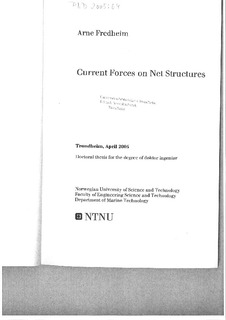| dc.description.abstract | The trend in recent years has been that the amount of wild catch is stagnating. In this perspective the selectivity of fishing gear has become an important issue. The aim of the present work has been to develop a three-dimensional model for the flow in front and inside a net structure, such as a trawl, to be able to predict and calculate selectivity of net structures. A net consist of twines which connect in knots and make up a mesh. The diameter of a twine can be from 1 [mm] in net cages up to a few centimeters in the front part of a trawl. And similar the size of the mesh can be from 1 [cm] up to the order of a meter. Typical Reynolds number range, related to the diameter of a twine, is O(102−104).
An examination of numerical results for the drag force on plane net structure demonstrates a strong dependency of the drag force on a net structure with both the geometry, in terms of Solidity ratio, and the Reynolds number. And in particular a non-uniform relation between the drag force and the Solidity ratio. It is evident that for increasing Solidity ratios, flow interaction will become increasingly significant. The physical design of the knot part contributes largely to this flow interaction.
The net structure is divided into discrete elements. The twines are modeled as separate cylinders between knots and the knots are modeled as separate spheres. Typically the total number of twines in a trawl could be in the order of 106 and it is thus impractical to model every single twine. It is assumed that for a given Reynolds number, keeping the Solidity ratio constant, the total drag on the trawl will be independent on the actual diameter and mesh opening of the net.
First each of these different elements is modeled as a set of source distributions and single point sources. The influence from the net on the fluid flow is then calculated by representing the wake generated by each element as source distributions along the structural element. To determine the strength of these sources the principle of Lagally is applied. Then a set of equations is obtained, describing the relation between the fluid velocity and the source strength at every element. Based on this approach, a method is presented to calculate the drag force on net structures with high solidity. The method uses appropriate drag coefficients related to the geometry of the twines and the knots and account for the change in the inflow due to the presence of the net structure and at the same time changes the geometry of the net structure due to the load.
Secondly the interaction between the net elements, due to the physical generation of a wake flow behind each individual element of the net, has been studied using a time-averaged wake model. Modifications are applied to the far-field mean velocity deficit mode by Schlichting (1968). This to better describe the the near-field behavior and the added effect of the wake from many individual cylindrical elements. It is shown that the wake model by Blevins (1990) can be used. The method is verified against experiments, as means of calculating the drag on plane nets as a function of Reynolds number, Solidity ratio and angle of attack and gives reasonable good agreement. During the experiments some interesting three-dimensional effects regarding the flow around cylinders were discovered. Negative lift forces occurring on the downstream cylinder in a staggered arrangement is explained as interactions due to upstream generated vortices.
To create a three-dimensional method where the inflow on each of the cylinders is corrected due to the presence of all the other cylinders, these two models are added together. Further, a structural analysis of the net structure, using a FEM method, is included in the model. A more complete description of the problem is obtained by combining the change in the inflow due to the presence of the net structure, with a correction of the shape and geometry due to the drag load.
Results from numerical simulation of different kinds of net structures, show that the elasticity in the net structure has a significant influence on the resulting geometry and calculated results. Further, the numerical results for net cages have been compared to experimental results. Good agreement between the numerical results and the experimental result is seen. Also the resulting geometry from the experimental results was recreated satisfactory using the present method.
For three-dimensional cone shaped net structures, in contrast to net panels and net cages, the presented numerical results do not indicate a large influence on the drag force due to changes in geometry. The agreement between the numerical and experimental results for fluid velocity in front and inside of a three-dimensional net structure, compared to experimental results, was reasonably good. Quantitatively the results do not match exactly, but the characteristics of the flow are recreated. Further, based on the numerical results for the fluid velocity, pressure field in front of a cone is presented. The relative pressure gradient is shown to be minimal, and it is not likely than any fish will detect this change in pressure field neither by direct pressure sensing nor by any sound created from any shed vortices. | nb_NO |
